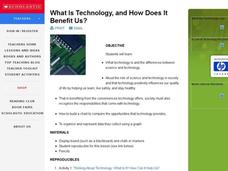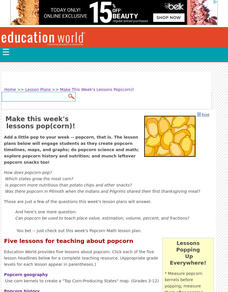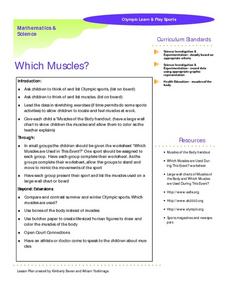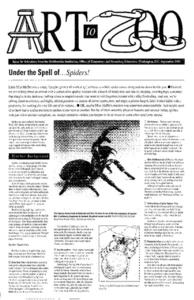Curated OER
Doing More In Less
Learners watch segments of a NASA program called "Doing More In Less". In groups, they examine the concept of human exploration and how NASA has contributed to specific research. They are introduced to new vocabulary and answer...
Curated OER
Perfection on Ice!: Math, Geometry, Fibonacci Numbers, Olympics
Students use the human body as a foundation for gaining practice in measuring angles and calculating ratios and proportions.
Curated OER
Caloric Expenditure in Powwow Dancing
Sixth graders investigate the meaning of different types of Native American music and dance. They determine how this music and dance has contributed to modern music and dance. They problem solve to determine the average length of the...
Curated OER
Pea Brain! Explorations in Estimation
Students estimate how many peas fit in a container. In this science instructional activity, students calculate the weight of a pea and record it. They use this data to calculate how many peas fit in a human brain.
Curated OER
Agriculture Shapes Kentucky History
Students explore the lives of early American Indians and settlers in Kentucky. They describe the agricultural practices of Indians native to Kentucky and develop a supply list for a group of settlers coming to the state to establish...
Curated OER
The Disappearing Honeybees: Tracking Honeybee Decline
Students practice graphing and other math skills to track number of honeybee colonies present in United States since 1978, discuss major crops that are dependent on insect pollinators, and examine reasons for decline of United States...
Curated OER
What Is Technology, and How Does It Benefit Us?
Students examine and define what technology is as well as the differences between science and technology. They assess the role of science and technology in society, conveniences technology offers and create a chart to compare the...
Curated OER
Parachutes, Circles and Pi...Oh My!
Students explore different size circles to discover the relationship between diameter and circumference. In this circles and Pi lesson, students construct simple parachutes using circle patterns of varying sizes. Students predict the...
Curated OER
Parachutes: What a Drag
Sixth graders make 2 different kinds of parachutes and record and graph the time for each one for the different drag forces. In this parachute lesson plan, 6th graders compare the results to the rest of the class of each parachute and...
Curated OER
Thematic Amusement Park Projects
Theme park lesson plans help students learn about history, science, and have fun at the same time.
Curated OER
Make This Week's Lessons Pop(corn)!
Students create popcorn timelines, maps, and graphs; do popcorn science and math; explore popcorn history and nutrition; and munch leftover popcorn snacks too!,
Curated OER
Gravity: It's GREEEAAATTT!
Students calculate effects of gravitational force on planets, discuss the effects of weightlessness on the human body and describe and demonstrate how objects in a state of free fall are accelerated by gravity at an equal rate.
Curated OER
Graze Like a Cow
Students explore how a cow digests the grass they eat. In this science/math lesson plan, students compare the quality of forage. Additionally, students determine the effects of rangeland health on the production.
Curated OER
By Land, Sea or Air
Students learn navigational techniques change when people travel to different places. They understand differences between navigation on land, water, air and in space. They explain the concept of dead reckoning as it applies to...
Curated OER
Which Muscles?- Olympic Learn and Play Sports
In this math, science, and physical education worksheet, students brainstorm and study about the muscles that are used while participating in different Olympic sports. They color the muscle groups of the body by follow the directions...
Curated OER
Under the Spell of Spiders
Young scholars examine spiders. In these spider lessons, students will view spider images and live spiders to determine physical characteristics, habits, and habitats. Young scholars will examine fantasy and folklore about spiders to...
Curated OER
Sizing Up the Supersize Croc
Students examine and compare traits of humans and crocodiles. In this crocodile lesson plan students use a ratio to estimate the height of a person and compare that to a crocodile.
Curated OER
Density
Students determine the density of different substances. In this physical science activity, students rank them according to their density. They discover the relationship between volume and density.
T. Smith Publishing
Finding Percentages 6A
A list of 20 two to three-digit numbers asks math whizzes to determine specified percentages for each. The publisher has linked the assignment to CCSS.Math.Content.6RP.3, and it is targeted at the discreet skill of finding a percent of a...
Curated OER
Designing a Study
Students explore features to consider when designing a scientific study. For this science research lesson, students examine different methods of data collection and consider which method would be appropriate for determining how many...
Curated OER
Design a Parachute
Students engage in a discussion about what a parachute is and how it works. They create a parachute using different materials that they think will work best. The students test their designs, which will be followed by a class discussion...
Curated OER
The North (Wall) Star
Young scholars engage in a lesson which shows them that celestial navigation is the art and science of finding one's geographic position by means of astronomical observations, particularly by measuring altitudes of celestial objects -...
Curated OER
Quick Stats with Quick Poll
Learners analyze data using bar graphs and the TI in this statistics lesson. They investigate quick polls and graph the data using different properties of statistics. This assignment requires a TI Navigator.
Curated OER
2.0 "Water Is Life" Global Water Awareness Mini-Unit (Grades3-5)
Students study the amount of potable water on the Earth. In this water lesson, students examine the amount of potable water as compared to all the water on the Earth. They discuss why many parts of the world do not have access to good...























